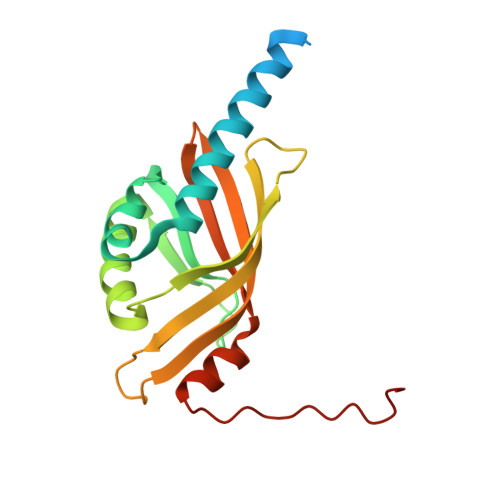PhzA/B catalyzes the formation of the tricycle in phenazine biosynthesis.
Ahuja, E.G., Janning, P., Mentel, M., Graebsch, A., Breinbauer, R., Hiller, W., Costisella, B., Thomashow, L.S., Mavrodi, D.V., Blankenfeldt, W.(2008) J Am Chem Soc 130: 17053-17061
- PubMed: 19053436
- DOI: https://doi.org/10.1021/ja806325k
- Primary Citation of Related Structures:
3B4O, 3B4P, 3CNM, 3DZL, 3EX9 - PubMed Abstract:
Phenazines are redox-active bacterial secondary metabolites that participate in important biological processes such as the generation of toxic reactive oxygen species and the reduction of environmental iron. Their biosynthesis from chorismic acid depends on enzymes encoded by the phz operon, but many details of the pathway remain unclear. It previously was shown that phenazine biosynthesis involves the symmetrical head-to-tail double condensation of two identical amino-cyclohexenone molecules to a tricyclic phenazine precursor. While this key step can proceed spontaneously in vitro, we show here that it is catalyzed by PhzA/B, a small dimeric protein of the Delta(5)-3-ketosteroid isomerase/nuclear transport factor 2 family, and we reason that this catalysis is required in vivo. Crystal structures in complex with analogues of the substrate and product suggest that PhzA/B accelerates double imine formation by orienting two substrate molecules and by neutralizing the negative charge of tetrahedral intermediates through protonation. HPLC-coupled NMR reveals that the condensation product rearranges further, which is probably important to prevent back-hydrolysis, and may also be catalyzed within the active site of PhzA/B. The rearranged tricyclic product subsequently undergoes oxidative decarboxylation in a metal-independent reaction involving molecular oxygen. This conversion does not seem to require enzymatic catalysis, explaining why phenazine-1-carboxylic acid is a major product even in strains that use phenazine-1,6-dicarboxylic acid as a precursor of strain-specific phenazine derivatives.
Organizational Affiliation:
Max-Planck-Institute of Molecular Physiology, Otto-Hahn-Strasse 11, 44227 Dortmund, Germany.

















